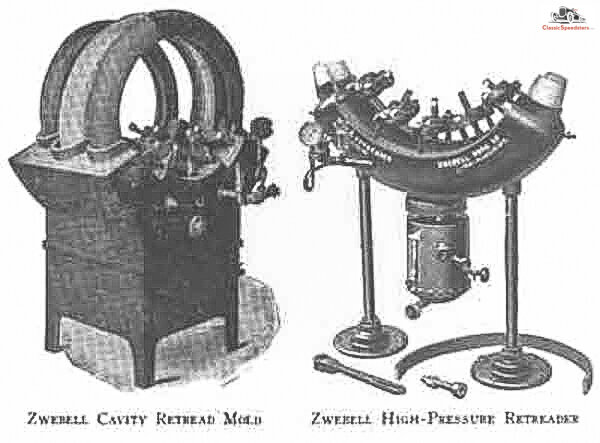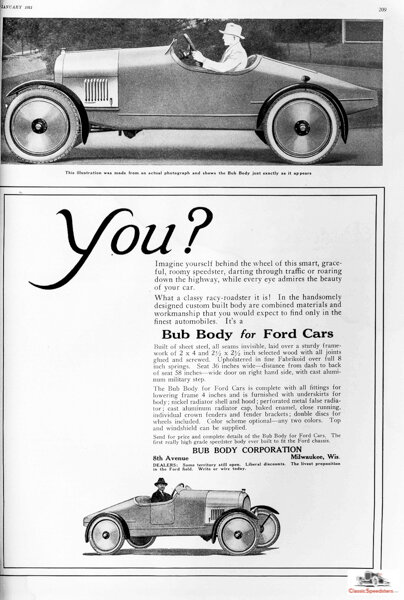Bub Body Corporation
Bub Body Corp was the brainchild of two out of three Zwebell brothers, enterprising Wisconsin wonder boys of the nineteen-teens. Between the three of them, they had invented a compact tire retreading machine that vulcanized using steam, cradling one-third of the tire at a time, out-retreading its competitors. Ingenious, compact enough for any small auto tire repair shop, it had made the Zwebells a bundle, and by 1920 they were rich enough to branch out.
1919 Zwebell Brothers retreading machine. Note that it grips about one-third of the tire at a time. Period image courtesy Caochbuilt .com
In 1921 Herbert and Albert incorporated a speedster body-making company and by September of that year had been granted a patent for it.
1921 Bub Body patent. Note the chisel tail. US Patent Office
Sporting a distinctive chisel tail, the all-steel Bub Speedster body was fastened to a glued-and-screwed 2-½”-square framing and secured onto a 2”X4” wooden chassis. The body itself, unlike its Model T donor, could be painted in any color using a two-tone paint scheme. Another option for the body was to cover it with Fabrikoid, an artificial leather made up of nitrocellulose-coated cotton, produced by DuPont primarily for seat covers. Available in any grain and color, of course. What would they think of next?
1921 Bub Body promotional postcard. Photo taken at the Federal Cord factory.
With an optional nickel-plated radiator cover, polished engine cover, and wheel discs, this car was the proverbial bee’s knees. Murray Fahnestock, ghost-writing under the pseudonym “Perry Scope,” wrote about happening upon a Bub Speedster in the April 1921 edition of the Ford Owner and Dealer. He had been drawn to a tightly-packed crowd on a street corner, and after elbowing his way in to see what was what, he discovered a remarkable Model T speedster in a glistening steel body. As “Perry” described it:
Everything considered, I believe this is one of the classiest replacement bodies I've ever seen. It's one of those cars, which, when seen darting through traffic, gliding down the boulevard or roaring down the highway, invariably creates a murmur of approval. No wonder it is the sensation of the year in Fordom!
Ford Owner and Dealer carried ads for the Bub Speedster, which apparently was receiving good press!
1921 Bub Body ad. Note the unique convertible top. Image courtesy AACA Library
The Bub Speedster was followed with another Bub body, the “Sport Cab.” Company ad copy best describes it:
Bub Sport Cab promotional release. Image courtesy Larry Sigworth collection
Bub speedsters were enthusiastically advertised or discussed in major trade journals such as Motor and Auto Trade Journal as early as January of 1921. However, almost as quickly as it flourished, the Bub Body Corp withered. The onslaught of the post-war depression in 1920, followed by a recession in 1922-23, or maybe the additional burden of a “war tax” produced an economic setback that crippled many a company, including Bub Body. It closed in 1923.
1921 Bub Body speedster ad as it appeared in Motor. Image courtesy Horseless Carriage Foundation Library
Not to be outdone, Arthur had already left the company and moved to Los Angeles in 1921 with his wife Nina for new opportunities. The two of them created small Spanish-style apartment complexes in West Hollywood that caught the eye of film director Cecile B. DeMille. DeMille commissioned some to be built near his studios, which in turn were inhabited by up-and-coming actors, and no doubt figured into several film settings in movies of the period. Today the six complexes, which pioneered the California Courtyard Apartment concept, are listed as National Historic Landmarks.
El Cabrillo courtyard, Hollywood, California. One of six apartment complexes designed by Arthur and Nina Zwebell in 1928. Image courtesy Wikipedia creative commons
Faultless
The Faultless Speedster bodies were an example of “one thing leads to another” in the automobile accessories business. And not unlike many of the aftermarket body companies that supplied young tinkerers toiling over Model T and Chevrolet 490 chassis, Fred Martin’s American Auto Top Company started developing and selling automobile tops out of a second-floor storage area.
Martin ran the Ford dealership in Delphi, Indiana in the early twentieth century. On his own time he had started to make an accessory that he called a “California top” for the Model T, as well as other tops for other makes too.
1921 ad for Faultless Tops. Image courtesy HCFI Library
Martin apparently found success, so along with three partners, decided to incorporate as the American Top & Body Company.
1924 Faultless Price List. Image courtesy Larry Sigworth collection
This was a small firm that by 1922 had expanded to selling speed parts, accessories, and the Faultless body kit to the fast Ford crowd.
Faultless Raceabout as it appeared in the 1924 catalog. Image courtesy Larry Sigworth collection
ATBC offered three different speedster bodies as seen in their 1924 catalog, depending on the client’s taste. The most emblematic example remains the one featured on their cover, the Raceabout Speedster, as seen above.
Additional speedsters offered in the 1924 catalog! Image courtesy Larry Sigworth collection
Not much is known about company history except that it was immersed in an economy that was growing as much as it was contracting. Nevertheless, ATBC prospered enough to continue on into the late 1920s as a speed parts supplier.
Parts as advertised in the 1924 catalog. Image courtesy Larry Sigworth collection
The Faultless Speedster was sold F.O.B. Delphi thorough the company catalog and, as with so many other speedster bodies from other companies, the Faultless Speedster was also carried in one national parts catalog or another. Faultless was probably successful enough to also be franchised, as other companies sold speedster kits similar in appearance to the Faultless. For instance, an unbranded example resembling the Faultless Raceabout featured prominently on page 815 of the Sears & Roebuck catalog! Now, to make it to the Sears catalog - that ain’t half bad!
Note the Faultless speedster body featured at the top of the page in this edition of the Sears, Roebuck & Co catalog. Image courtesy Larry Sigworth collection
Histories of these companies have been made possible through research done by folks like Larry Sigworth, member of the Model T Ford Club of America, as well as Mark Theobold of www.Coachbuilt.com. This editor is indebted to their scholarship.
Next issue we will look at the cutdown movement that infected early tinkerers of the Ford Model T and the Chevrolet 490. Keep your cranks handy and your thumbs tucked in!














